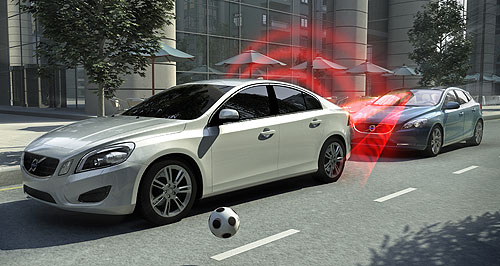Make / Model Search
News - General News - SafetyENCAP applies emergency brake pressureSafety first: Mercedes-Benz helped pioneer crash avoidance technology with the Pre-Safe Brake system. Automatic braking systems next on car safety crusader’s name and shame list7 Jun 2012 EUROPE’S safety watchdog is set to put car-makers under the microscope by publicising the roll-out of models fitted with the next big thing in life-saving crash-avoidance technologies – autonomous emergency braking (AEB). The European New Car Assessment Program (ENCAP) next week will release the results of a survey of car models equipped with the technology that can use radar or laser-based ‘lidar’ systems to identify an imminent collision, warn the driver and, if necessary, brake automatically. Six manufacturers – Volvo, Mercedes-Benz, Honda, Volkswagen, Ford and Audi – have so far been listed on ENCAP’s web site as having such a system in their European arsenal, and thus winning recognition in the ENCAP Advanced awards program. But in Brussels next week the safety organisation will take its campaign for universal adoption of such technologies to a new level with an event to raise awareness for AEB. Marking the 15th anniversary of ENCAP, the event will pump up publicity for companies with aggressive plans for the technology rollout, while effectively naming and shaming companies that are dragging the chain on AEB introduction. As well, the organisation will hold public demonstrations of the technology, along with a debate on the subject, involving safety experts, engineers and European Union policy-makers who will discuss the benefits of AEB and progress in its market penetration. One of the pioneers of AEB is Mercedes-Benz, which calls its system Pre-Safe Brake. This radar-based system scans up to 200 metres ahead of the car between 30km/h and 200km/h, first warning the driver should a hazard be detected and then applying the correct braking force once the driver gets on the anchors to bring the car to a safe stop, regardless of brake pedal pressure. If the driver fails to brake, the system applies partial braking and tensions the seat-belts one and a half seconds before impact, and if the system determines that impact cannot be avoided, maximum braking force is applied automatically. ENCAP’s survey will not only focus on “car to car” crash mitigation systems but what it calls “car to vulnerable road user” technology, which refers to systems such as Volvo’s City Safety and Subaru’s Eyesight, both of which are designed to detect pedestrians, cyclists or other road users.  Read more |
Click to shareGeneral News articlesResearch General News Motor industry news |











Facebook Twitter Instagram